公開日 2024年01月11日
大船遺跡の「縄文の森」は,縄文時代の植生や景観の再現を目指したエリアで,自然を身近に感じながら観察できる場所となっています。
※大船遺跡内は落ちている実や種子も含めて採取禁止です。皆さんに見ていただくためのものですので,実や枝を取らないでください。
“Jomon Forest” in the Ofune Site is the recreated area for visitors to be able to observe the vegetation and landscape of the Jomon period while enjoying nature.
※ Picking of any parts of the plant including fallen fruits and seeds in the Ofune Site is strictly prohibited. All plants here are for viewing only. Please do not take branches or fruits away.
ここでは,「縄文の森」を構成する木々について解説します。
The following is an introduction to the trees found in the Jomon Forest.
クリ Chestnut tree
学名|Castanea crenata
ブナ科
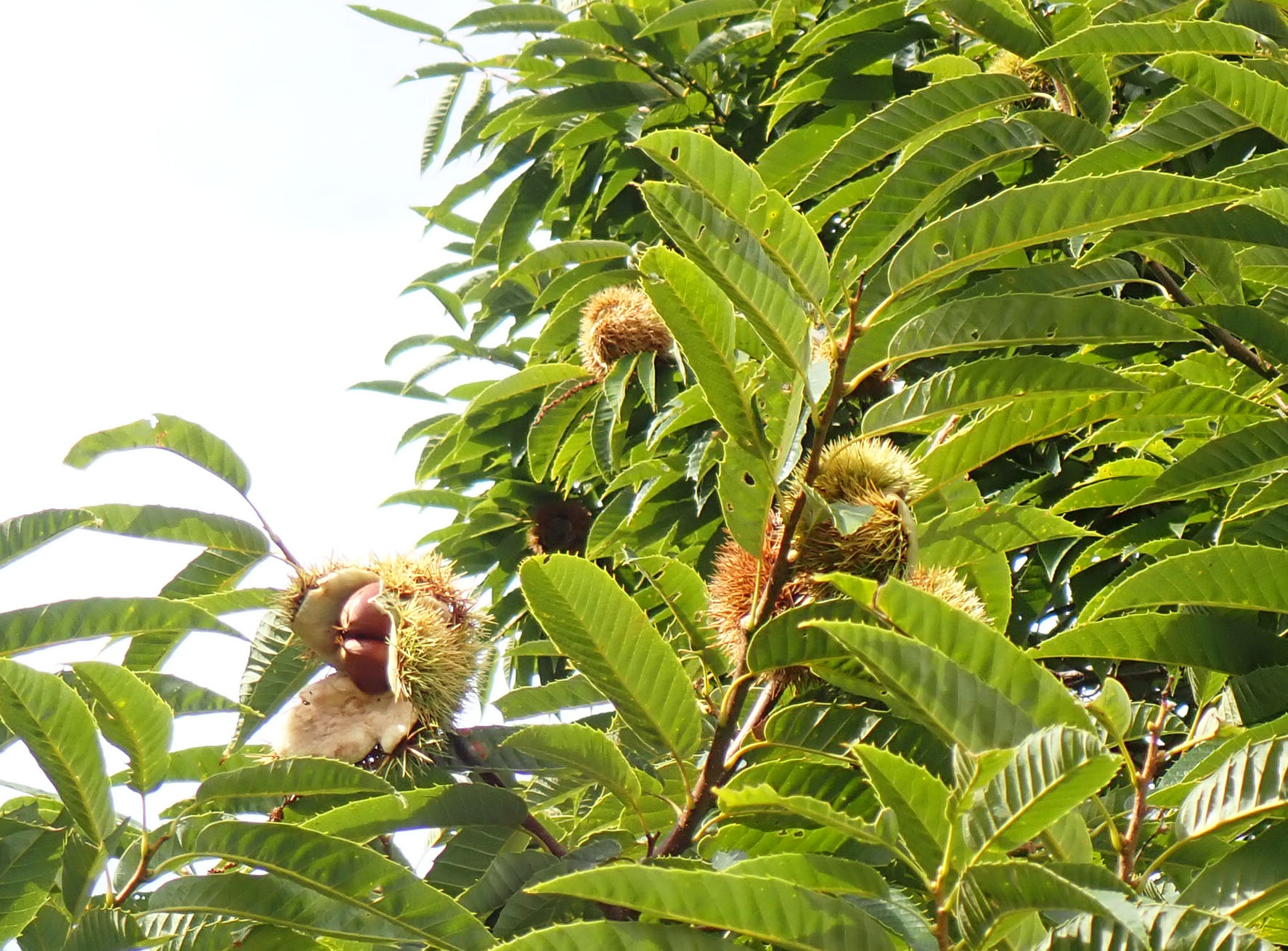
クリの果実 Fruit of chestnut tree
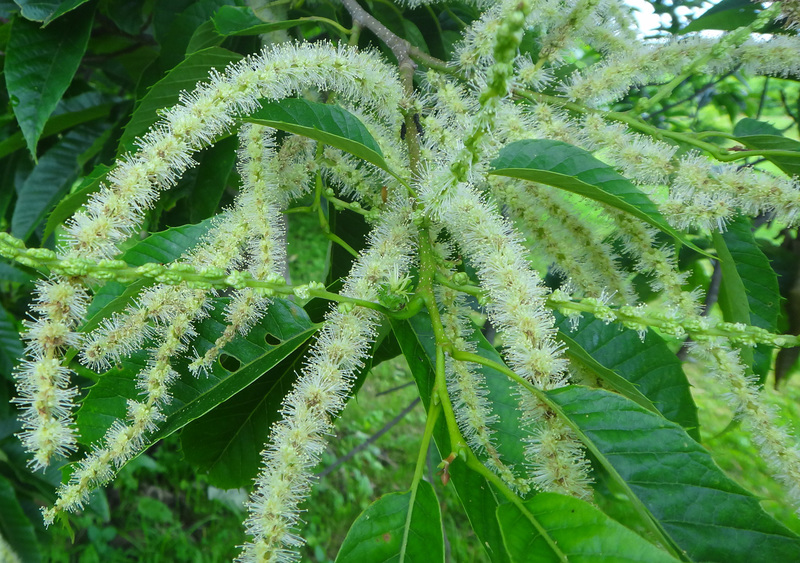
クリの花序 Anthotaxy of chestnut tree
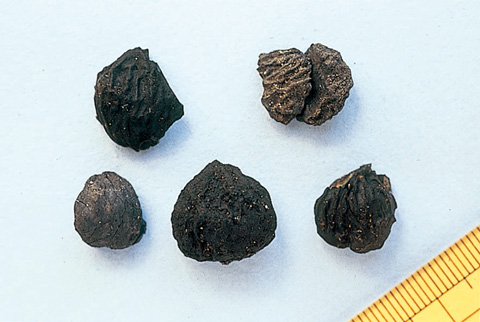
大船遺跡から出土した炭化クリ Carbonized chestnuts
北海道(石狩より南西部)から九州まで広く分布する落葉高木です。もともと北海道にクリは分布していませんでしたが,縄文時代に本州から持ち込まれ,縄文人に育てられたクリが定着したと考えられています。
7月頃に小さい花の集まり(花序)が穂のように作られ,上部に雄花,下部に雌花が咲きます。10月~11月にいがに包まれた果実(堅果)が熟します。
南茅部地域から出土したクリの年代は縄文時代前期(約6,000年前)以降のものであり,道内で最も古い時期の出土例です。
大船遺跡では住居跡から炭化したクリが200個ほど出土しており,縄文人の主要な食料であったと考えられています。また,竪穴建物の柱材のほとんどがクリ材であるなど,クリは縄文時代の重要な資源でした。
Chestnut tree is a deciduous tall tree widely-spread from the south-southwest of Hokkaido to Kyushu. Chestnut trees had not been distributed in Hokkaido, and the Jomon people have made them entrenched after being introduced from Honshu during the Jomon Period.
Chestnut trees excavated in the Minamikayabe area are about 6,000 years old, which is the oldest excavated tree in the south Hokkaido.
Two hundreds of carbonized chestnuts have been excavated from the remains of a dwelling of the Ofune Site, which indicates the Jomon people mainly ate chestnuts as their staple diet. Chestnut trees were also an important resource for Jomon people to build their pit dwellings.
オニグルミ Japanese walnut
学名|Juglans mandshurica var. sachalinensis
クルミ科
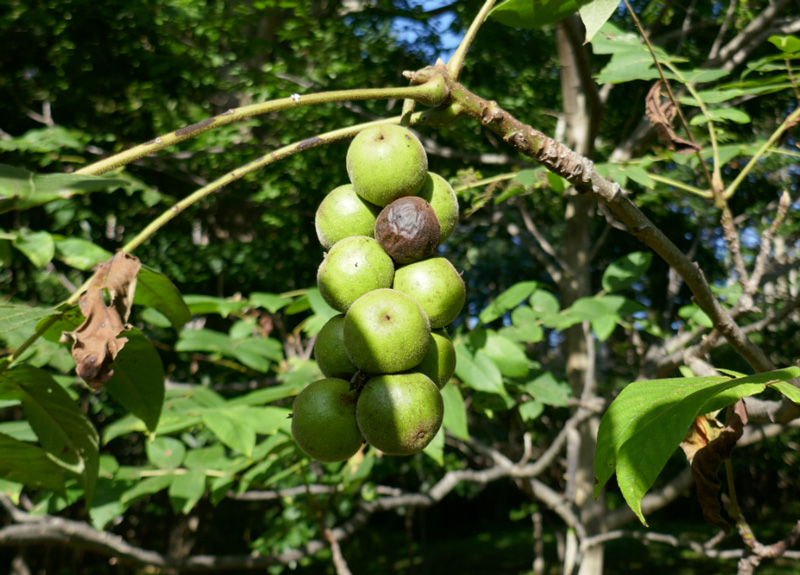
オニグルミ Fruit of Japanese walnut
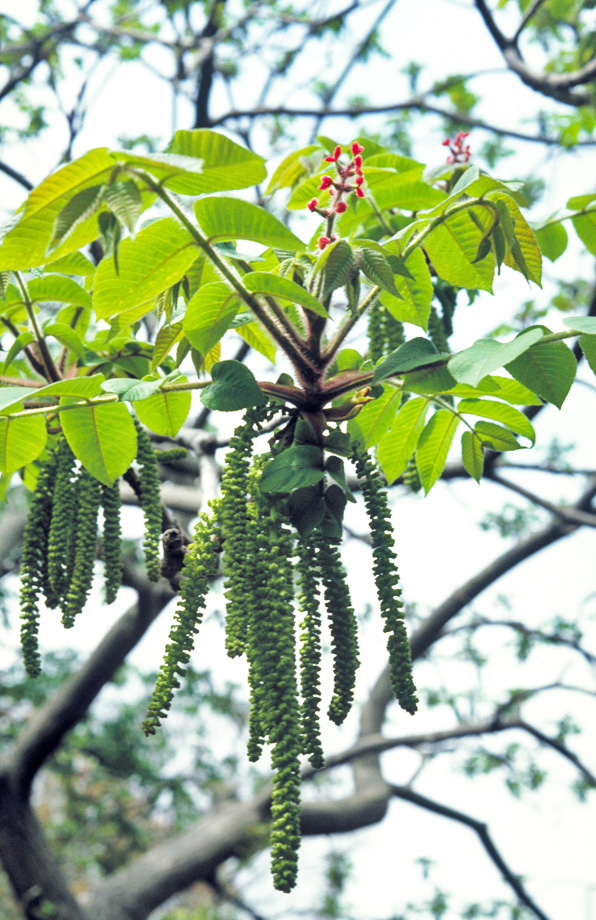
オニグルミの花 Male flower of Japanese walnut
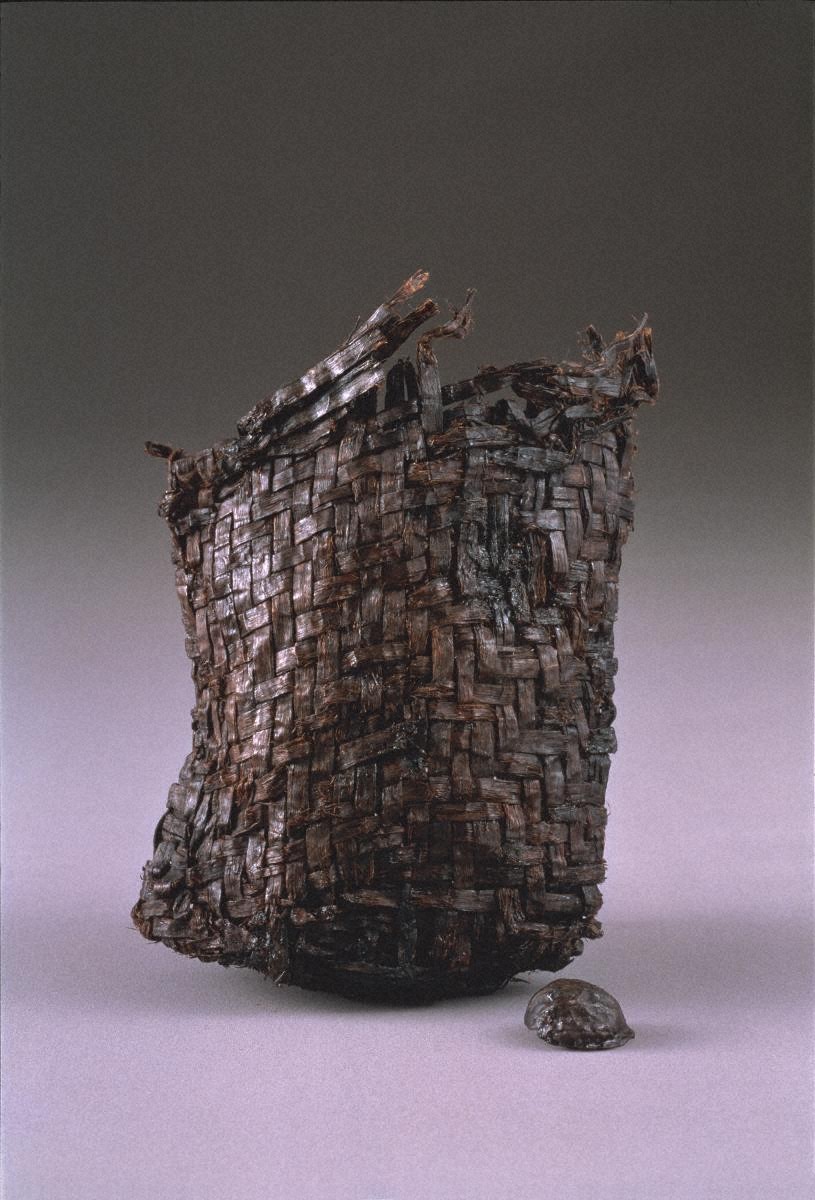
三内丸山遺跡センター所蔵 編籠と中に入っていたクルミ(出典:Sanmaru Search)
Wicker basket and Japanese walnut found in it (cited from: Sanmaru Search)
全国に広く分布する落葉高木です。雄花と雌花が別々になっており,雄花はひも状に垂れ下がります。果実の中に硬い殻に包まれた種子があり,それを食用にします。
大船遺跡をはじめ,南茅部地域の多くの遺跡から炭化した殻や花粉が発見されるなど,広く食料として利用されていたことがわかっています。
木材としても,加工しやすく強度もあり,縄文時代から使われていました。
Japanese walnut is a deciduous tall tree widely-spread all over Japan.
Carbonized shells and pollens of Japanese walnut have been found in many remains in the Minamikayabe area, including the Ofune Site, indicating that Japanese walnut was used as food.
Japanese walnut trees are strong and easy to process, so they were used as building materials in the Jomon Period.
バッコヤナギ(ヤマネコヤナギ) Goat willow
学名|Salix caprea
ヤナギ科
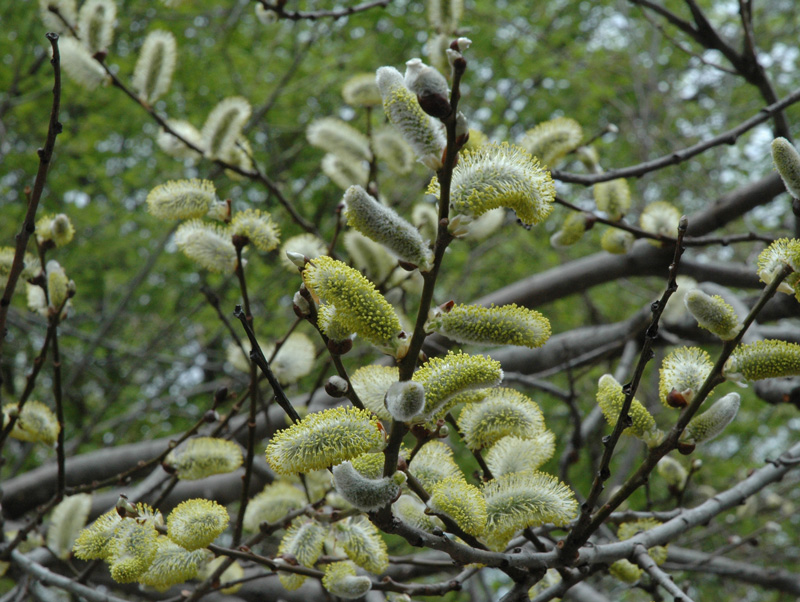
バッコヤナギの雄花 Male flower of goat willow
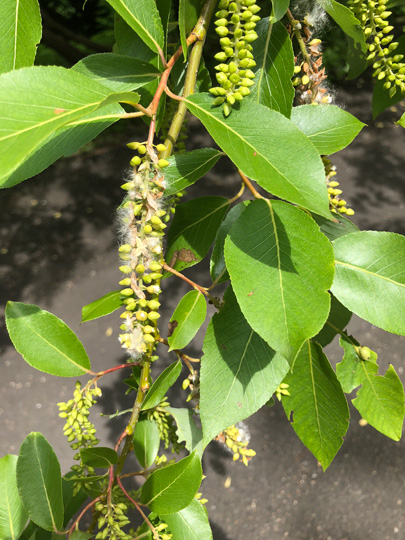
バッコヤナギの果穂 Aggregate fruit of goat willow
全国に分布する落葉小高木で,春一番に花が咲く樹木の一つです。白く長い毛を付けた雄花はまるでネコのしっぽのようで,ネコヤナギあるいはヤマネコヤナギの名前で呼ばれることもあります。果穂(かすい:複数の果実が集まったもの)は垂れ下がり,初夏に実が開いて白い綿毛のついた種子が風に舞います。
Goat willow is a deciduous small tree spread all over Japan, and the flowers bloom in early spring. The aggregate fruits are hung down, and the seeds are produced in summer.
エゾニワトコ Red elder
学名|Sambucus racemosa subsp. kamtschatica
ガマズミ科
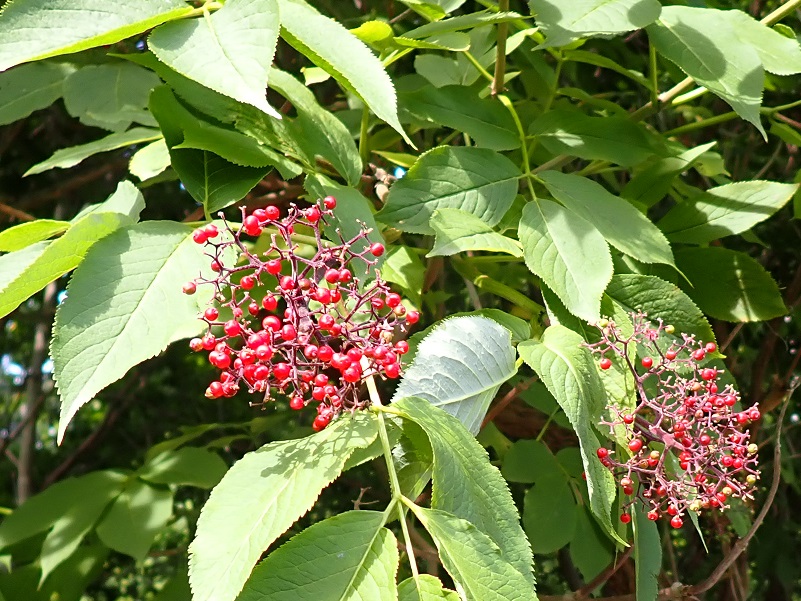
エゾニワトコの果実 Fruit of red elder
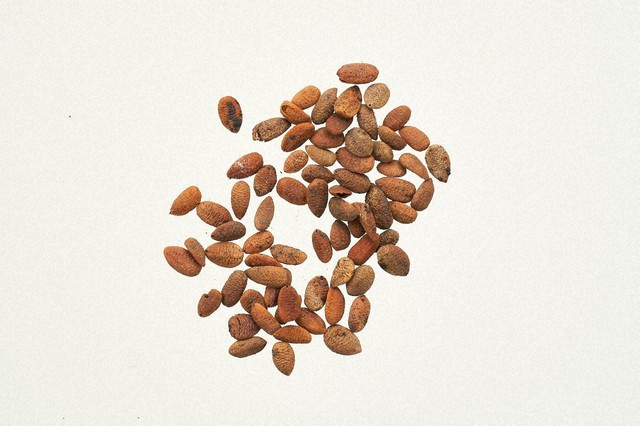
三内丸山遺跡センター所蔵 ニワトコ属種子(出典:Sanmaru Search)
Seed of red elder (cited from: Sanmaru Search)
本州に広く分布するニワトコの別亜種であり,東北日本~北海道に分布する落葉低木です。
春に白い花が咲き,夏に果実が赤く熟します。
縄文時代の遺跡からは,ニワトコ類の種子がまとまって出土することがあり,果実を発酵させて果実酒を作っていたという説がありますが,実際に発酵させてもアルコール分はごく微量で酒にはならないため,縄文時代にどのように利用されていたかは謎です。
Red elder is a deciduous bushy tree spread from Northeast Japan to Hokkaido.
The white flowers bloom in spring and the red fruits ripen in summer.
Since the seeds of red elder have been found in groups from the remains of the Jomon Period, it is said that the Jomon people might fermented the fruits to distill liquor. However, the amount of alcohol obtained through fermentation is actually not enough to distill liquor. How red elder trees were used in the Jomon Period remains unknown.
ノリウツギ(サビタ) Panicled hydrangea
学名|Hydrangea paniculata
アジサイ科
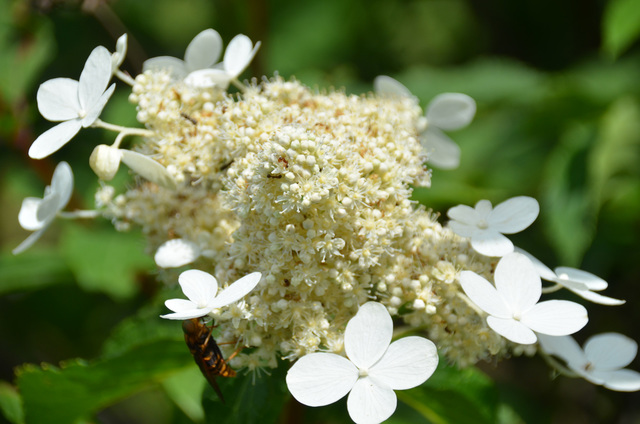
ノリウツギの花 Flower of panicled hydrangea
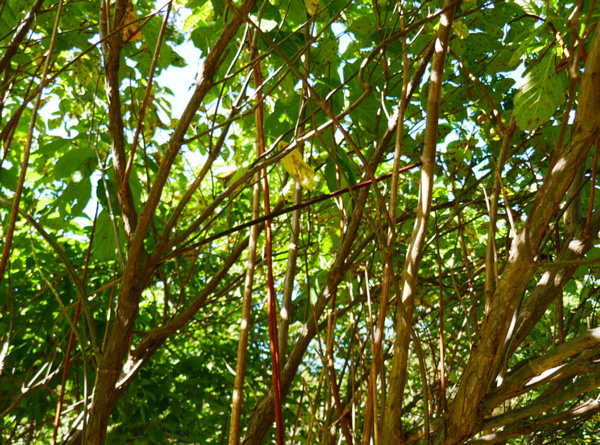
ノリウツギの枝 Branch of panicled hydrangea
全国の山野に分布する落葉低木であり,北海道では湿地に多く,木も本州より大きくなります。夏には,枝先に純白の小さな花をたくさん付け,花の周囲にはがくがまるで花びらのようになった装飾花(飾り花)があります。
北海道や東北では,サビタと呼ばれることもあります。
樹皮の内側に粘液が含まれており,手すき和紙の「ネリ」の原料としても知られています。
恵庭市のユカンボシE11遺跡から縄文時代中期のノリウツギ製の矢柄が出土し,矢柄に使える真っ直ぐなササ類の無い北海道ではノリウツギの徒長した真っ直ぐな枝を使っていたことが分かりました。
Panicled hydrangea is a deciduous bushy tree spread in the mountains and the fields all over Japan. Panicled hydrangea found in Hokkaido grow in marshy places and are taller than those found in Honshu.
The inside of the bark of the tree contains mucilage, which is used to make Japanese traditional handmade paper.
Arrow shafts made of panicled hydrangea used in the Middle Jomon Period were excavated from the Yukanboshi E11 Site in Eniwa city, which indicates that the branch of panicled hydrangea was used to make arrow shaft in Hokkaido.
ミズナラ Japanese oak
学名|Quercus crispula
ブナ科
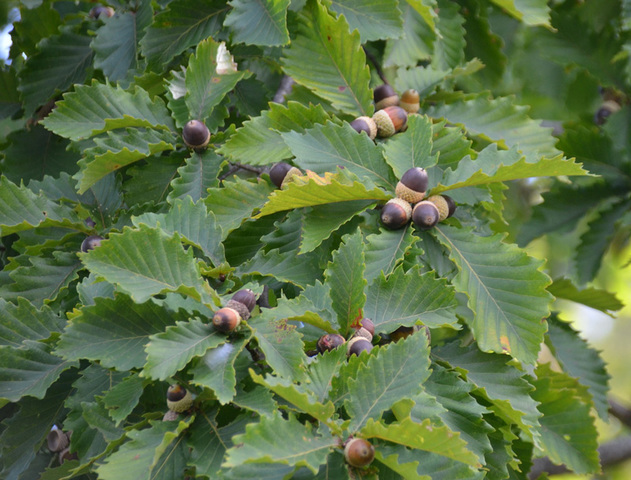
ミズナラの果実 Fruit of Japanese oak
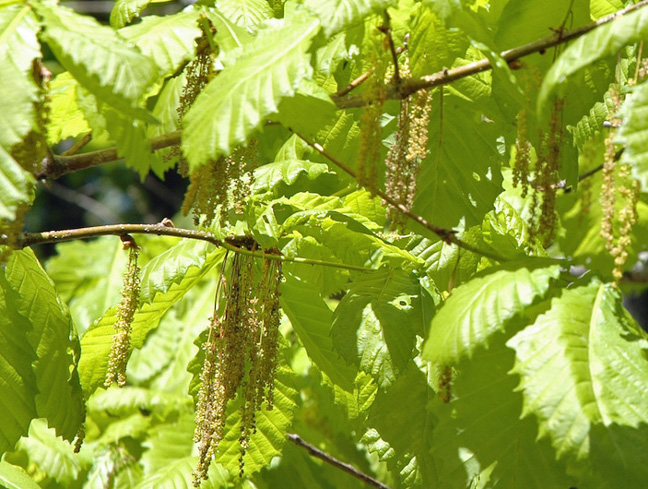
ミズナラの雄花序 Male inflorescence of Japanese oak
全国に分布している落葉高木で,大きいものは幹の直径が1mを超え,長齢で各地に古い大きな木が残っています。
5月頃,葉が開くとともに花を付けますが,雌雄の花が別のところに付き,雄花序(雄花の集まり)はひも状に垂れ下がり,枝先にある雌花序は全く目立ちません。10月頃に実る果実はいわゆるドングリです。クリと同様にデンプンが多く含まれますが,そのままでは食べられないので,あく抜きが必要となります。
縄文時代には水にさらしたり土器で煮ることであく抜きし,すり潰して団子やクッキーのようにして食べていたと考えられています。
Japanese oak is a deciduous tall tree spread all over Japan. The diameter of the trunk can be more than one meter. The tree lives for a long time and can be found in many places.
The fruit of Japanese oak is so-called “acorn”. Acorns contain a lot of starch, but cannot be eaten raw. It is considered that the Jomon people skimmed off scum from acorns by soaking them in water or by boiling them in Jomon ware, then ground them and made dumplings or cookies to eat.
エゾノウワミズザクラ Bird cherry
学名|Prunus padus
バラ科
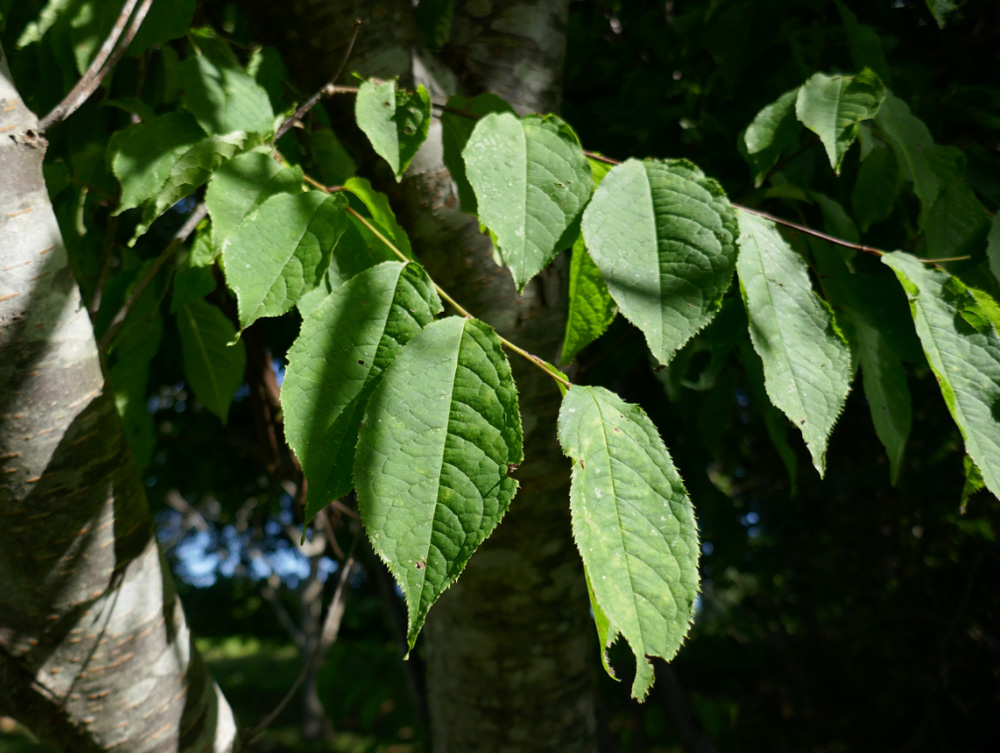
エゾノウワミズザクラの葉 Leaf of bird cherry
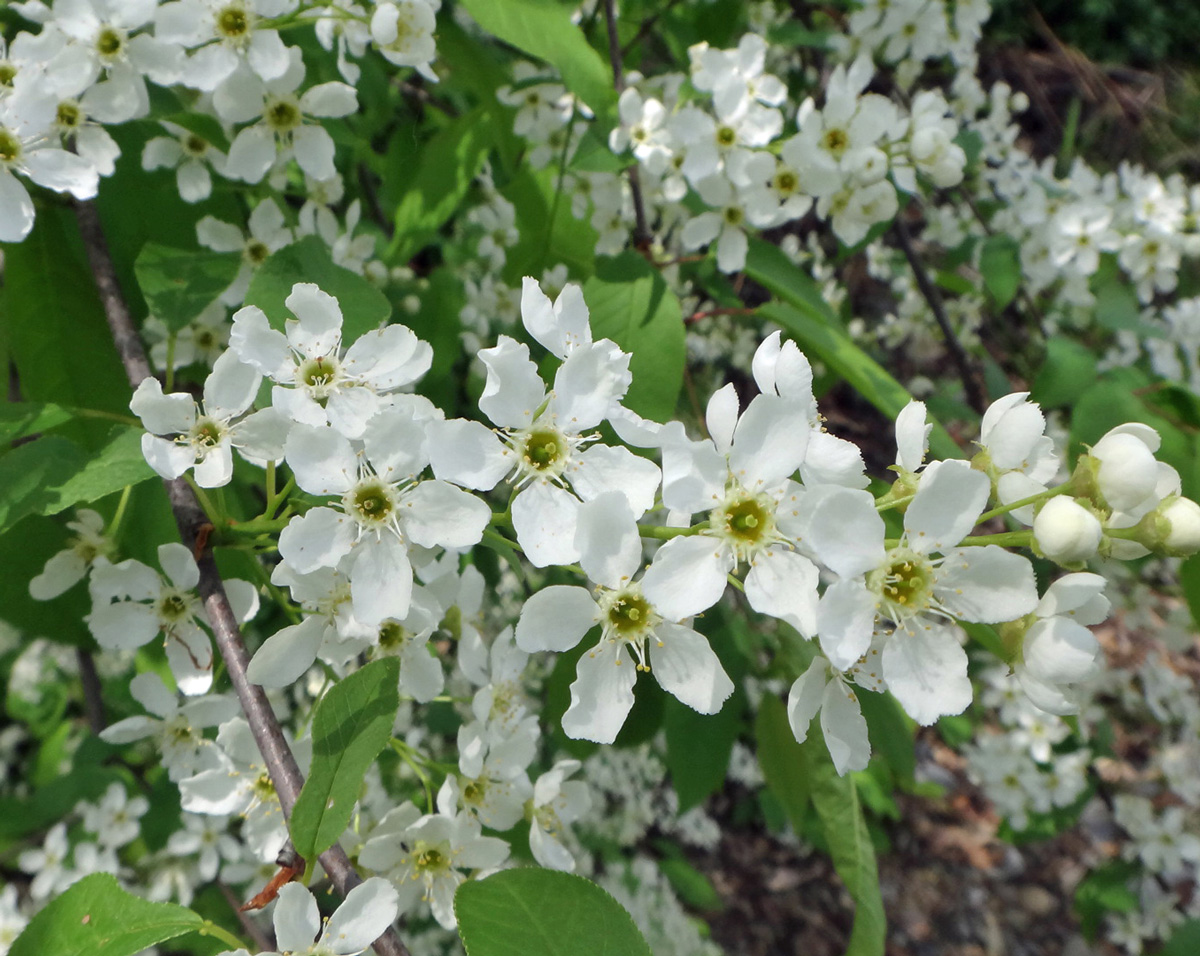
エゾノウワミズザクラの花 Flower of bird cherry
北海道と,青森県の一部に分布し,5月下旬に梅の花に似た白い花が穂のように咲きます。実を付けにくく,地下茎を伸ばしてクローンを作ることで生息域を広げます。
Bird cherry trees are spread in Hokkaido and part of Aomori. White flowers, which look like those of the plum tree, bloom late in May.
オオヤマザクラ(エゾヤマザクラ) Sargent's cherry
学名|Cerasus sargentii var. sargentii
バラ科
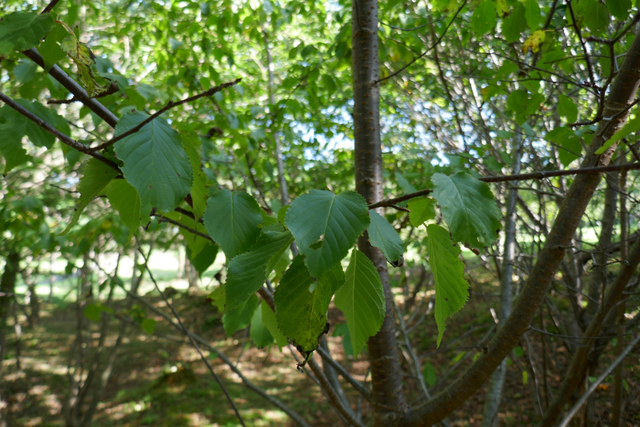
オオヤマザクラの葉 Leaf of sargent's cherry
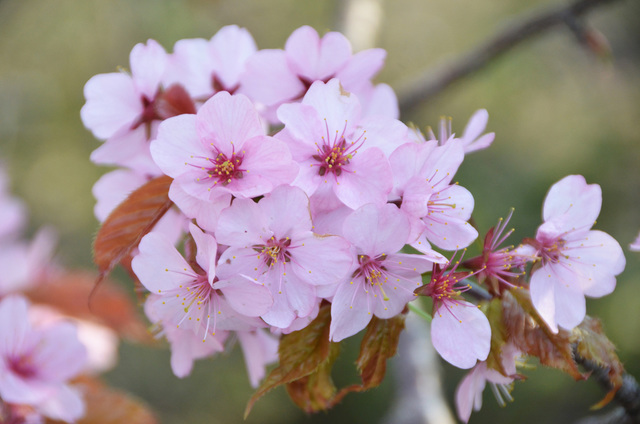
オオヤマザクラの花 Flower of sargent's cherry
東日本から北海道に広く分布している落葉高木であり,北海道では最もポピュラーな花で, エゾヤマザクラとも呼ばれます。5月頃にピンク色のきれいな花を咲かせ,果実は「サクランボ」の姿をしていますが苦くて食べられません。サクラ類の木材は,縄文時代には漆器の木地としてよく利用され、また樹皮が巻き紐として使われました。
函館市指定の天然記念物「旧臼尻村役場のオオヤマザクラ」は大舟川上流から移植されたものです。縄文時代の人たちも花見を楽しんだのかもしれません。
Sargent's cherry is a deciduous tall tree widely-spread from East Japan to Hokkaido. In the Jomon Period, the wood of sargent's cherry tree was often used for wooden basis of lacquerware, and the bark of the tree was used to make thin ropes.
Sargent's cherry tree on the site of the Former Usujiri Village Office, which is designated as a protected species of Hakodate, was transplanted from the upper area of Ofune River. The Jomon people might also enjoy cherry blossom viewing.
シナノキ(アカジナ) Japanese linden
学名|Tilia japonica
シナノキ科
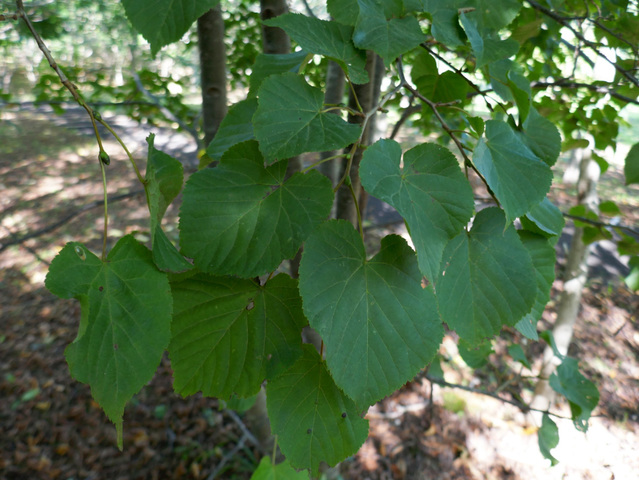
シナノキの葉 Leaf of Japanese linden
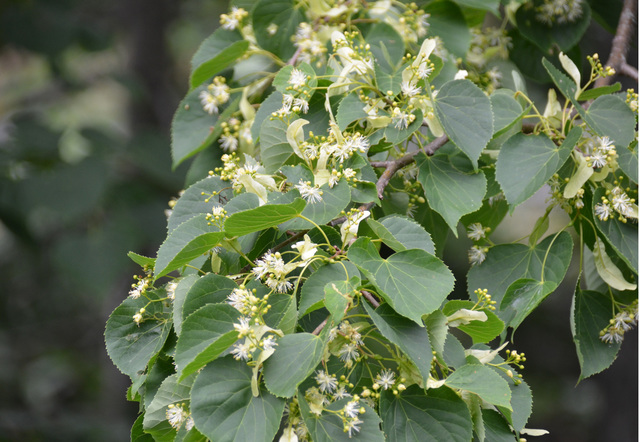
シナノキの花 Flower of Japanese linden
全国の山地に自生する落葉高木であり,北海道では低山地に多くみられます。アカジナと呼ばれることもあります。春には白色のへら状の苞葉(ほうよう)に乗って小花を房状に付け,丸い実が実ります。
樹皮を剥いて採った繊維は縄や糸にして織物になります。縄文時代の遺跡からあんぎん編みの布や細い縄などが出土していて,当時からシナノキの樹皮の繊維が利用されていたことが分かります。
Japanese linden is a deciduous tall tree grown in the mountains all over Japan. The trees are found in the low-mountain area in Hokkaido.
The fibers peeled from the bark of the tree are spun into ropes or threads to weave fabric. It is considered that the fibers of Japanese linden were used in the Jomon Period, since some pieces of woven cloth and thin rope are excavated from the remains of the Period.
ヤマグワ Chinese mulberry
学名|Morus australis
クワ科
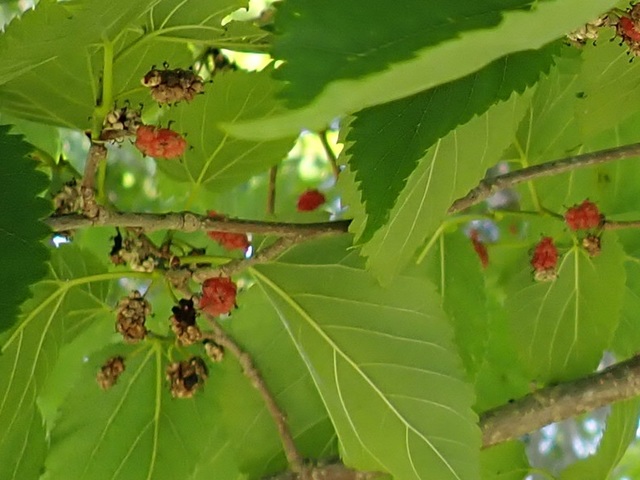
ヤマグワの果実 Chinese mulberry
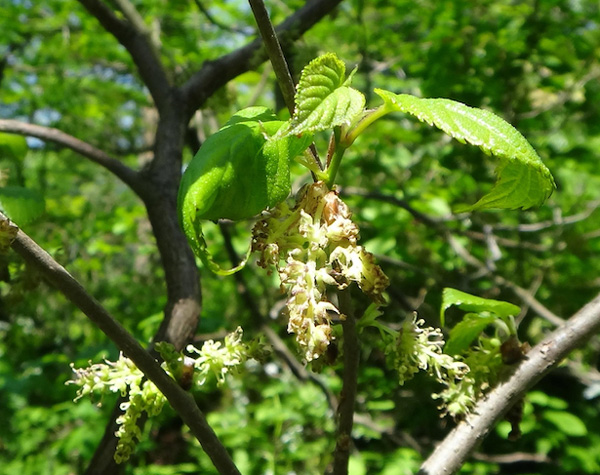
ヤマグワの雄花序 Male inflorescence of Chinese mulberry
全国の山野に自生する落葉小高木であり,湿潤な沢沿いなどに特に多くみられます。春には,葉が開くとともに目立たない小花の集まった雄花序,雌花序を別々に付けます。6月から7月上旬に果実ができ,初めは赤く,その後黒紫になって熟し,甘くなって食べられるようになります。
木材は堅く良質で,さまざまな道具の材料に使われます。縄文時代の遺跡からは果実や木材が出土しており,縄文時代から利用されていたことが知られています。
Chinese mulberry is a deciduous small tree grown in the mountains and the fields all over Japan, and found mostly in humid areas along the stream.
The wood of Chinese mulberry is hard and excellent in quality, so it is used as a material for a variety of tools. It is considered that Chinese mulberry trees were used in the Jomon Period, since the fruit and the wood are excavated from the remains of the Jomon Period.
シラカンバ(シラカバ) White birch
学名|Betula platyphylla var. japonica
カバノキ科
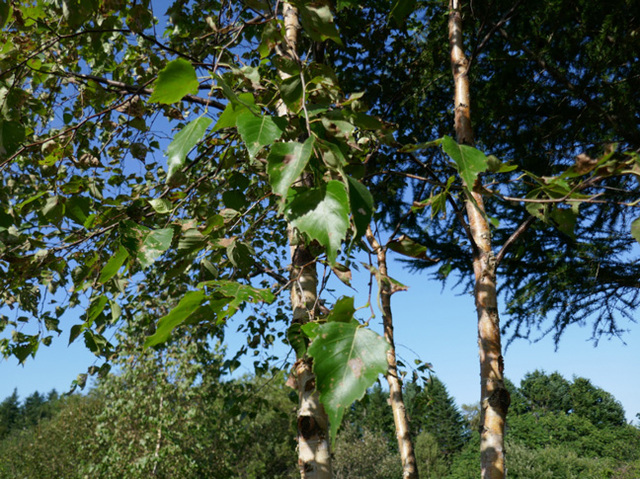
シラカンバの幹 Trunk of white birch
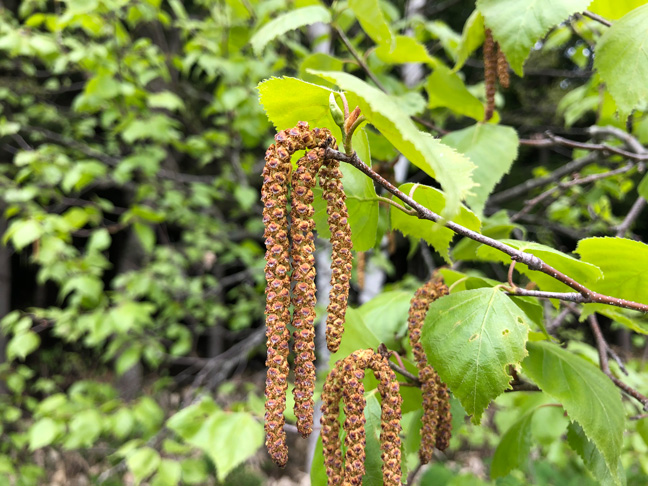
シラカンバの雄花序 Male inflorescence of white birch
全国の温帯域に分布する落葉高木であり,東北から北海道では平地でも見ることができます。樹皮の白さが特徴的で,白樺(シラカバ)とも呼ばれます。春には,葉を開くとともに雌雄別々に花を付けます。雄花序(雄花の集まり)はひも状に垂れ下がり,雌花序が枝先に付きますが全く目立ちません。果穂(かすい:小さい果実が集まったもの)は細長く,秋に熟し鱗片と翼をもつ果実がバラバラになって散らばります。
アイヌや北方の諸民族は,樹皮を住居の壁材や屋根葺き材,編み組みして容器などに利用していました。北日本の縄文時代の遺跡からは取り置きされた樹皮や樹皮製品が見つかっています。
White birch is a deciduous tall tree spread in temperate regions all over Japan. The trees are also found in a flat area in Tohoku and Hokkaido.
Ainu and Northern Peoples used to utilize the bark of the tree for woven containers as well as for the wall and roof materials of their houses. Pieces of peeled bark and some products made of bark were found in the remains of the Jomon Period.
ハウチワカエデ(メイゲツカエデ) Japanese maple
学名|Acer Japonicum
カエデ科
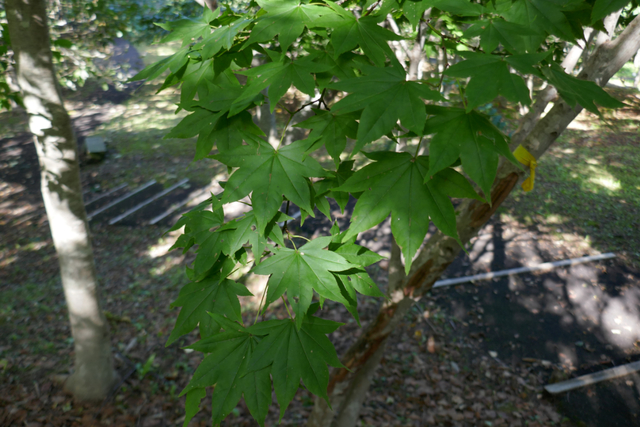
ハウチワカエデの葉 Leaf of Japanese maple
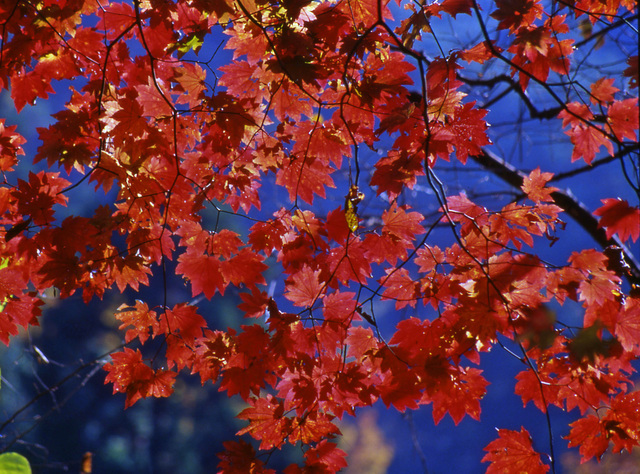
紅葉したハウチワカエデ Colored leaf of Japanese maple
雑木林や落葉樹林に生える落葉小高木であり,紅葉の色づきが見事です。名月楓(メイゲツカエデ)と呼ばれることもあります。春には,葉を開くとともに小さい赤色の小花を付け,向かい合った二つの果実が大きな翼を持ち,飛行機のプロペラのような果実(翼果)となります。
カエデの仲間は木材が堅く粘りがあり,縄文時代の遺跡からはさまざまな道具の材料として出土しています。
Japanese maple is a deciduous small tree grown in the woods and the forest, and the leaves turn red in fall beautifully.
The wood of the maple tree is hard and sticky. Various tools made of the wood of the maple tree were excavated from the remains of the Jomon Period.
タラノキ(タランボ) Japanese angelica-tree
学名|Aralia elata
ウコギ科
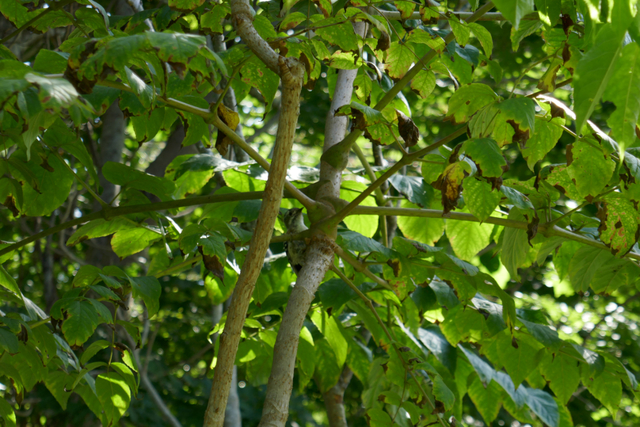
タラノキの幹 Trunk of Japanese angelica-tree
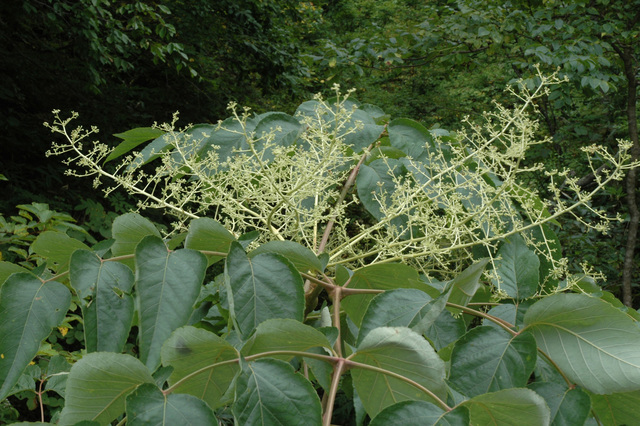
タラノキの花序 Anthotaxy of Japanese angelica-tree
開けた山野や二次林(山火事などで原生林が破壊された後に再生した林)によくみられる落葉小高木であり,枝は太く,大きな三角形の葉を付けます。タランボとも呼ばれます。春には,枝先に小さい花が集まった大きな花序を付けます。果実は丸い粒状で,房状に多数実ります。新芽は山菜の王様と言われるほど美味で,多くの人に親しまれています。
実が食用となるわけでもなく,木材も軟らかくて有用でないため,縄文時代の遺跡からの出土は少ないですが,縄文人も新芽を食べていたかもしれません。
Japanese angelica-tree is a deciduous small tree grown in the open hills or the secondary forest.
Although the shoots of the Japanese angelica-tree are delicious and called as the king of wild vegetables, the fruit is not edible and the wood is too soft to utilize. Not many of the Japanese angelica-tree were found in the remains of the Jomon Period. However, Jomon people might eat shoots of the Japanese angelica-tree like people today.
おまけ | 運が良ければ会えるかも
Additional Information | You are lucky if you see them!
エゾリス Hokkaido squirrel
学名|Sciurus vulgaris orientis
リス科
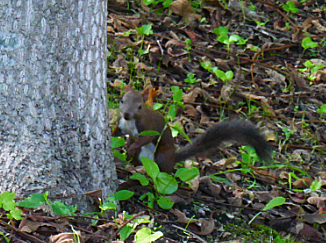
こちらを向いたエゾリス Hokkaido squirrel facing front
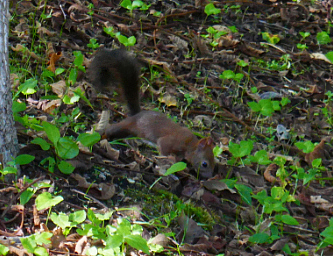
何かを探すエゾリス Hokkaido squirrel searching for something
北海道の森林や林に生息する小型の哺乳類です。雑食性で木の実やキノコの他に昆虫も食べます。昼行性であり,冬でも冬眠せず活動します。
ドングリやクルミなどの木の実を土に埋めて,冬の間の保存食とする習性があります。雪が積もっていても掘り出せますが,埋めた場所を忘れてしまうことがあります。
Hokkaido squirrels are small omnivorous mammals living in the forests and the groves in Hokkaido. They eat insects as well as nuts and mushrooms. They are diurnal and non-hibernating.
Hokkaido squirrels bury acorns and walnuts in the ground for their preservative food during wintertime. They can dig those foods from the snow-covered ground, but sometimes forget where they are.

























































